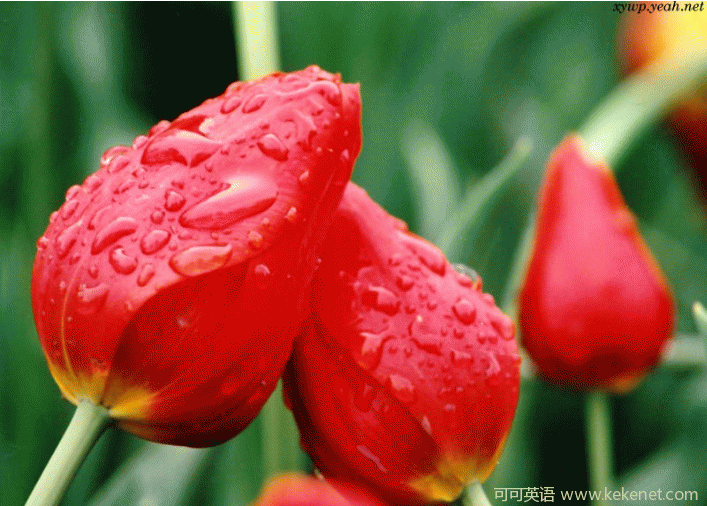
I finally arrive in the tulip capital of the Netherlands, Leiden, a 15th century textile city where Rembrandt was born and learned how to paint. It's where Clusius planted the first tulips in Western Europe and it's where Holland's first university was founded, a reward granted by William of Orange for the city's bravery in battle against his Spanish Catholic oppressors. But I'm here to learn something about tulips, so I make my way to the Hortus Botanicus in Leiden University. Founded in 1590, it's the oldest botanical garden in the Netherlands and it's where the Dutch national flower-the tulip-was first cultivated.
我終于到達了荷蘭的郁金香之都——利登。十五世紀時這里還是一座紡織城市,倫勃朗就在這里出生并學習繪畫。克魯西烏斯在這兒種下了西歐第一批郁金香。荷蘭的第一所大學也在這兒創立,那是奧蘭治親王威廉因其勇敢對抗西班牙天主教壓迫者而授予的獎賞。而我在這兒是想了解關于郁金香的知識,于是我到了利登大學的植物園。這座植物園于1590年成立,是荷蘭最古老的植物園,也是荷蘭國花郁金香第一次種植的地方。
Tulip means "turban" and that gives us a clue that the flower didn't originate in Holland but in the steppes of Central Asia where it still grows as a wild flower. The Persians named it after the Sikh headwear that it resembled. The Turks named it "tülbent", and the French and Latin intervention corrupted the name to what we affectionately call it as: the tulip.
郁金香的意思是"穆斯林的頭巾",這表明這種花并非源自荷蘭,而是出自中亞的草原,現在仍在那里的野外生長。波斯人認為它像錫克教頭巾,因此以之為其命名。土耳其人稱之為"圖利班",后因受法文和拉丁文的影響,最終演變為我們現在溫柔輕喚的名字:郁金香。
The Turks have been cultivating tulips since the 10th century, although it wasn't until Suleiman the Magnificent ruled a vast Ottoman Empire 600 years later that the flower was given importance, for Suleiman reigned during a golden age of Ottoman power and grandeur, a period in time called the Tulip Age.
土耳其人自十世紀就開始種植郁金香,但一直到六百年后蘇萊曼大帝開始統治龐大的奧斯曼帝國,這種花卉才得到了重視。蘇萊曼統治時期,正是奧斯曼帝國最強盛的時期,那個時期又被稱為"郁金香時代"。
Carolus Clusius was the first director for this garden in the late 1500s. He was credited for cultivating the tulip in Western Europe when he got bulbs from his friend who was an ambassador for the Ottoman Empire. And thanks to the Dutch climate and its chalky sandy soil, the tulip flourished and thus an industry was born.
卡羅勒斯·克魯西烏斯在16世紀末擔任這花園的首任園長。人們把在西歐種植郁金香的功勞歸于他,當時他從朋友——奧斯曼帝國的大使那兒得到了花的球莖。依靠著荷蘭的氣候和白堊沙土壤,郁金香茂盛生長,郁金香產業隨之誕生。
The tulip stock market crashed in 1637 because everyone, both rich and poor, was growing tulips and, of course, they lost their unique value. Dealers went bankrupt and the government was forced to send soldiers to control the supply.
郁金香期貨市場在1637年崩潰。因為不論貧或富,人人皆種郁金香,這必然令它們喪失了自己獨特的價值。商人們破產,政府不得不派軍隊控制供應。
But it's a love affair that has never gone away for Holland remains the world's biggest flower exporter, a thriving business which takes place in the Aalsmeer Flower Auction, where $800 million worth of plants are traded each year. The flower auction itself is like a Dutch version of Wall Street, albeit contested with great propriety by local growers and wholesalers bidding for buckets as they are trolleyed into view and shown off. Only 12% of flowers will be sold to Dutch flower shops. The rest are destined for export.
但人們對它的熱愛之情并未消褪,荷蘭仍是世上最大的花卉出口國。阿爾斯梅爾花卉拍賣市場生意蓬勃。每年有價值八億美元的植物在此出售。花卉拍賣猶如荷蘭版的華爾街。當一車車的郁金香被推進展廳展示時,本地種植商和批發商很有規矩地爭相進行競拍。盡管如此,只有12%的花銷往荷蘭本地花店,其余則用作出口。












